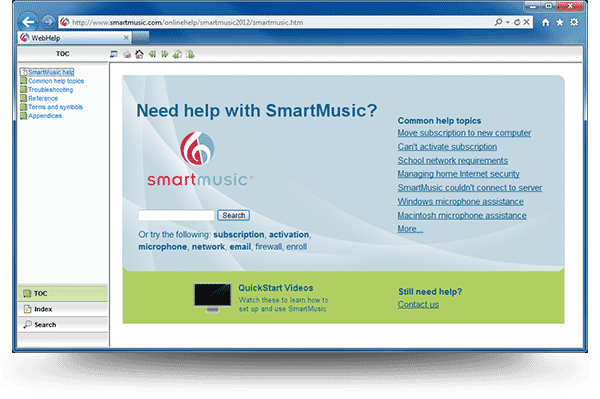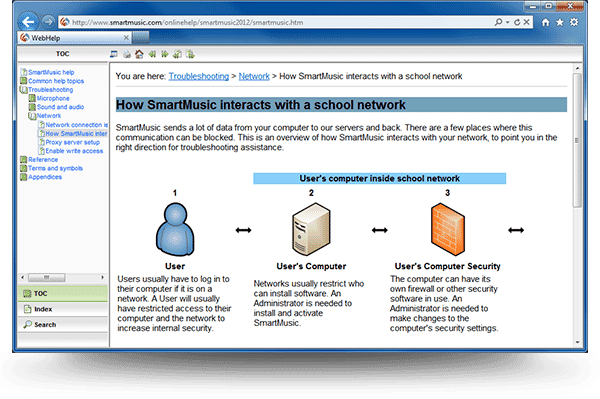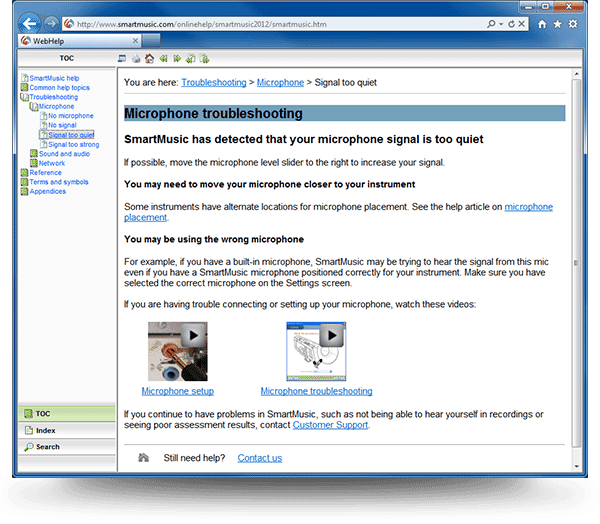Customer Success Story
Leading Provider of Music Software Replaces Print Product Guides with Interactive Online Help using MadCap Flare
Goals
- Deliver online Help for music software customers
- Provide users an easier and more intuitive way to access information
- Provide timely updates to the Help system that address customers' top questions
- Provide a consistent Web experience for all users
- Replace legacy authoring and publishing tool with modern multi-channel publishing tool
Benefits
- Dynamic, intuitive Flare-based Help systems replaced lengthy print and static installed documentation
- Context-sensitive Help lets users directly connect to relevant Help topics from within MakeMusic's software
- Help updates that occurred only once or twice a year, now typically happen every other week
- Flare style templates let MakeMusic copy and paste content from the knowledge base software into the Help system and have it automatically formatted
- A link with Google Analytics lets MakeMusic see what Help topics are currently of greatest interest to customers and adjust the Help systems accordingly
MadCap Software Solutions and Services:
As one of the world's premier music software providers, MakeMusic®, Inc. understands that the quality of the customer's experience with its applications is only as good as the understanding of how to take advantage of them. That is why the company has turned to MadCap Flare to create and publish dynamic, context-sensitive Help on the Web. In doing so, MakeMusic has eliminated the need to produce lengthy print product guides for its popular Finale® and SmartMusic® software.
"In the past, Finale was supported by five volumes of print documentation," said Mark Maronde, SmartMusic project coordinator. "Now with our Flare-based online Help systems in place, Finale simply comes with a small printed quick reference guide, and there's no print documentation for SmartMusic at all."
For more than two decades, MakeMusic has been a leading provider of music software, including Finale, the world standard for music notation software, and SmartMusic, the award-winning interactive application for enriching music practice. Today, more than 2.5 million musicians, composers, arrangers, teachers and students use MakeMusic products.
In the past, MakeMusic used a legacy authoring tool to publish print documentation for Finale and SmartMusic. By moving to Web-based Help, MakeMusic aimed to provide customers with a dynamic, intuitive system for answering their questions. MakeMusic first used MadCap Flare to convert its Finale product guide to an online Help system. More recently, the success of the Finale Help system led MakeMusic to adopt Flare for the SmartMusic Help system as well.
With our Flare-based Help, we're providing several ways for people to solve their problems as quickly as possible, and unlike our previous tool, Flare enables users to get the same results, no matter what browser they use.
Mark Maronde Project Coordinator, SmartMusic

"We were going through a major rewrite of our SmartMusic software with a completely new user interface, and we saw an opportunity to rethink our approach to Help," recalls Maronde. "When I heard from my counterpart on the Finale team about how Flare was helping them, it was an easy decision to upgrade to Flare, too."
MadCap Flare's topic-based approach and support for context-sensitive Help have played particularly important roles in the development of the new SmartMusic Help system. Using Flare, MakeMusic has created a series of topics that address common customer questions. The team also has wired context-sensitive Help IDs into the MakeMusic application, so that when users click on a specific term or feature in the software, it automatically opens up the relevant page in the Flare Help system. Additionally, the SmartMusic Flare Help system portal includes a search field where users can enter keywords to search for topics.

"With our Flare-based Help, we're providing several ways for people to solve their problems as quickly as possible," Maronde notes. "And unlike our previous tool, Flare enables users to get the same results, no matter what browser they use."
Another goal for MakeMusic has been to synchronize the online Help system with the interactive knowledge base and forums managed by the company's technical support and customer service teams.
"The knowledge base typically features topical articles that are constantly changing, but when the content can be applied more broadly, it's easy to add it to our Help system," Maronde says. "I simply copy and paste HTML content from the knowledge base into Flare and then apply the template to it."
Flare's functionality also has made it easy to enhance the user's visual experience, including the ability to integrate videos that Maronde has developed, and match the Help system's look to that of the SmartMusic application.

"We had the artist who created the user interface for SmartMusic also design the SmartMusic Help page. I then implemented it in Flare using a little Javascripting," Maronde recalls. "It looks consistent, and it's really appealing."
Initially there was a learning curve with Flare, but Maronde says the light bulb went on for him when he was reading the HTML and XML guides and came to the explanations of style sheets that were separate from content and how to use cascading style sheets. He notes, "MadCap has done a really good job of organizing extremely deep functionality with Flare. Everything seems to be in the right place, and managing different output targets is very easy."
Perhaps one of the most significant changes is how quickly MakeMusic can revise its Help content using Flare. In the past, print documentation would be updated once or twice a year at most. By contrast, the Web-based Help is typically updated every other week. Some of these changes are based on minor technical updates, but others are influenced by Google analytics of Web hits to the Help system, which identify the topics that are currently most important to customers.
"Now we know when the customer cares more about download issues than microphone issues," Maronde explains. "The ability to respond to that knowledge and dynamically update Web content with Flare is just fantastic. It ensures that we're giving customers the information they need when they need it."






